Evaluation of the Fatigue Behavior and Failure Mechanisms of 4340 Steel Coated with WIP-C1 (Ni/CrC) by Cold Spray
Abstract
:1. Introduction
2. Materials and Methods
2.1. Coating Process
2.2. Samples and Equipment Used for Tensile Testing
2.3. Methodogy of Fatigue Analysis Performed on Coated Samples
3. Results
3.1. SEM Analysis of 4340 Steel Base Material
3.2. Fracture Analysis at Static Loading
3.3. Samples B and C (σmax (MPa); N), (637; 3794) and (530; 15,726)
3.3.1. Macroscopic Observations
3.3.2. Microscopic Observations
3.4. Samples D and E (σmax (MPa); N), (496; 26,688) and (424; 59,291)
3.4.1. Macroscopic Observations
3.4.2. Microscopic Observations
3.5. Samples I and J (σmax (MPa); N), (389; 91,986) and (371; 119,450)
3.5.1. Macroscopic Observations
3.5.2. Microscopic Observations
3.6. Samples K and L (σmax (MPa); N), (361; 190,536) and (353; 291,111)
3.6.1. Macroscopic Observations
3.6.2. Microscopic Observations
3.7. Samples G and H (σmax (MPa); N), (318; 5,000,208) and (346; 5,000,099)
3.8. Microstructure of Samples K and H after Fatigue Test
3.9. Wӧhler Diagram for Fatigue Tested 4340 Coated Samples
4. Summary and Discussion
5. Conclusions
- -
- For high stress loading, close to the yield strength value, significant damage of the coating layer is found at the interface with the base material. These failures consisted of detachment of coating material as well as microcracks, which appeared near the area of crack initiation.
- -
- At high stress values, the deflection of the cracked surfaces at certain angles is observed. In the initiation region of this deflection, where the deformation (especially the plastic ones) is large, the coating material detaches from the base material. Additionally, the area of stable crack propagation in the base material has an uneven appearance.
- -
- Given that, at high stresses, the damage to the coating material is significant, it is not recommended to use coated and fatigue-strained components above 370 MPa. If the stress values are between 350 MPa and 370 MPa, the damage to the coating material is reduced, and, for medium durability, the components can be used within this range of stresses without affecting the base material and coating assembly.
- -
- At fatigue stress levels below 340 MPa, no damage occurred in the tested base and the coating over 5 million cycles. Therefore, it is concluded that parts made of AISI 4340 alloy steel and coated with WIP-C1 (Ni/CrC) powder using CS can be expected to operate with high durability if the applied fatigue stresses do not exceed 340 MPa, even considering the presence of the stress concentrators.
Author Contributions
Funding
Institutional Review Board Statement
Informed Consent Statement
Data Availability Statement
Conflicts of Interest
References
- Kumar, S.; Ghosh, P.K.; Kumar, R. Surface modification of AISI 4340 steel by multipass TIG arcing process. J. Mater. Process. Technol. 2017, 249, 394–406. [Google Scholar] [CrossRef]
- Malakondaiah, G.; Srinivas, M.; Rao, P.R. Ultrahigh-strength low-alloy steels with enhanced fracture toughness. Prog. Mater. Sci. 1997, 42, 209–242. [Google Scholar] [CrossRef]
- Bilal, M.M.; Yaqoob, K.; Zahid, M.H.; Tanveer, W.H.; Wadood, A.; Ahmed, B. Effect of austempering conditions on the microstructure and mechanical properties of AISI 4340 and AISI 4140 steels. J. Mater. Res. Technol. 2019, 8, 5194–5200. [Google Scholar] [CrossRef]
- Nawrocki, J.G.; Dupont, J.N.; Robino, C.V.; Puskar, J.D.; Marder, A.R. The mechanism of stress-relief cracking in a ferritic alloy steel. Weld. J. 2003, 25–35. [Google Scholar]
- Yamamoto, I.; Kobayashi, T. Service-induced changes in the microstructure and mechanical properties of a Cr-Mo-Ni-V turbine steel. ISIJ Int. 1997, 37, 1133–1138. [Google Scholar]
- Zhan, Y.Z.; Du, Y.; Zhuang, Y.H. Chapter Four—Determination of Phase Diagrams Using Equilibrated Alloys. In Methods for Phase Diagram Determination; Elsevier: Amsterdam, The Netherland, 2007; pp. 108–150. [Google Scholar]
- Istrate, B.; Rau, J.V.; Munteanu, C.; Antoniac, I.V.; Saceleanu, V. Properties and in vitro assessment of ZrO2-based coatings obtained by atmospheric plasma jet spraying on biodegradable Mg-Ca and Mg-Ca-Zr alloys. Ceram. Int. 2020, 46, 15897–15906. [Google Scholar] [CrossRef]
- Baragetti, S.; Tordini, F. A Review of the Fatigue Behaviour of Components Coated with Thin Hard Corrosion-Resistant Coatings. Open Corros. J. 2011, 4, 9–17. [Google Scholar] [CrossRef]
- Champagne, V.K.; Helfritch, D.J. Mainstreaming cold spray–push for applications. Surf. Eng. 2014, 30, 396–403. [Google Scholar] [CrossRef]
- Nikbakht, R.; Seyedein, S.H.; Kheirandish, S.; Assadi, H.; Jodoin, B. The Role of Deposition Sequence in Cold Spraying of Dissimilar Materials. Surf. Coat. Technol. 2019, 367, 75–85. [Google Scholar] [CrossRef]
- Nikbakht, R.; Assadi, H.; Jodoin, B. Intermetallic Phase Evolution of Cold-Sprayed Ni-Ti Composite Coatings: Influence of As-Sprayed Chemical Composition. J. Therm. Spray Technol. 2021, 30, 119–130. [Google Scholar] [CrossRef]
- Richer, P.; Jodoin, B.; Ajdelsztajn, L. Substrate Roughness and Thickness Effects on Cold Spray Nanocrystalline Al-Mg Coatings. J. Therm. Spray Technol. 2006, 15, 246–254. [Google Scholar] [CrossRef]
- Al-Mangour, B.; Mongrain, R.; Irissou, E.; Yue, S. Improving the Strength and Corrosion Resistance of 316L Stainless Steel for Biomedical Applications Using Cold Spray. Surf. Coat. Technol. 2013, 216, 297–307. [Google Scholar] [CrossRef]
- Mauer, G.; Singh, R.; Rauwald, K.-H.; Schrufer, S.; Wilson, S.; Vaßen, R. Diagnostics of Cold-Sprayed Particle Velocities Approaching Critical Deposition Condition. J. Therm. Spray Technol. 2017, 26, 1423–1433. [Google Scholar] [CrossRef]
- Wang, X.; Feng, F.; Klecka, M.A.; Mordasky, M.D.; Garofano, J.K.; El-Wardany, T.; Nardi, A.; Champagne, V.K. Characterization and modeling of the bonding process in cold spray additive manufacturing. Addit. Manuf. 2015, 8, 149–162. [Google Scholar] [CrossRef]
- Moridi, A.; Hassani-Gangaraj, S.M.; Guagliano, M.; Dao, M. Cold spray coating: Review of material systems and future perspectives. Surf. Eng. 2014, 30, 369–395. [Google Scholar] [CrossRef]
- Chatha, S.S.; Sidhu, H.S.; Sidhu, B.S. High temperature hot corrosion behaviour of NiCr and Cr3C2–NiCr coatings on T91 boiler steel in an aggressive environment at 750 °C. Surf. Coat. Technol. 2012, 206, 3839–3850. [Google Scholar] [CrossRef]
- Bagherifard, S.; Guagliano, M. Fatigue performance of cold spray deposits: Coating, repair and additive manufacturing cases. Int. J. Fatigue 2020, 139, 105744. [Google Scholar] [CrossRef]
- Price, T.S.; Shipway, P.H.; McCartney, D.G. Effect of cold spray deposition of a titanium coating on fatigue behavior of a titanium alloy. J. Therm. Spray Technol. 2006, 15, 507–512. [Google Scholar] [CrossRef]
- Sansoucy, E.; Kim, G.; Moran, A.; Jodoin, B. Mechanical characteristics of Al-Co-Ce coatings produced by the cold spray process. J. Therm. Spray Technol. 2007, 16, 651–660. [Google Scholar] [CrossRef]
- Barnes, J.; Champagne, V.; Ballard, D.; Eden, T.J.; Shoffner, B.; Potter, J.K.; Wolfe, D.E. Mechanical and Microstructural Effects of Cold Spray Aluminum on Al 7075 Using Kinetic Metallization and Cold Spray Processes. Lockheed Martin Aeronatical Syst. Marietta GA, 2007; Preprint; AFRL-ML-WP-TP-2007-431. [Google Scholar]
- Ghelichi, R.; MacDonald, D.; Bagherifard, S.; Jahed, H. Microstructure and fatigue behavior of cold spray coated Al5052. Acta Mater. 2012, 60, 6555–6561. [Google Scholar] [CrossRef]
- Ghelichi, R.; Bagherifard, S.; Mac Donald, D.; Brochu, M.; Jahed, H.; Jodoin, B.; Guagliano, M. Fatigue strength of Al alloy cold sprayed with nanocrystalline powders. Int. J. Fatigue 2014, 65, 51–57. [Google Scholar] [CrossRef]
- Dayani, S.B.; Shaha, S.K.; Ghelichi, R.; Wang, J.F.; Jahed, H. The impact of AA7075 cold spray coating on the fatigue life of AZ31B cast alloy. Surf. Coat. Technol. 2018, 337, 150–158. [Google Scholar] [CrossRef]
- Yang, J.; Yang, J.; Xie, J.; Wang, Q.; Qu, K. Improved fatigue crack propagation performance of Q355B steel with cold-sprayed A5052 and Al coatings. Surf. Coat. Technol. 2019, 378, 125000. [Google Scholar] [CrossRef]
- Xiong, Y.; Zhang, M.X. The effect of cold sprayed coatings on the mechanical properties of AZ91D magnesium alloys. Surf. Coat. Technol. 2014, 253, 89–95. [Google Scholar] [CrossRef] [Green Version]
- Jeong, C.Y.; Ha, S. Fatigue properties of Al-Si casting alloy with cold sprayed Al/SiC coating. Int. J. Cast Met. Res. 2008, 21, 235–238. [Google Scholar] [CrossRef]
- Kumar, S.S.; Bae, G.; Lee, C. Influence of substrate roughness on bonding mechanism in cold spray. Surf. Coat. Technol. 2016, 304, 592–605. [Google Scholar] [CrossRef]
- Bae, G.; Kumar, S.; Yoon, S.; Kang, K.; Na, H.; Kim, H.J.; Lee, C. Bonding features and associated mechanisms in kinetic sprayed titanium coatings. Acta Mater. 2009, 57, 5654–5666. [Google Scholar] [CrossRef]
- Hussain, T.; McCartney, D.G.; Shipway, P.H.; Zhang, D. Bonding mechanisms in cold spraying: The contributions of metallurgical and mechanical components. J. Therm. Spray Technol. 2009, 18, 364–379. [Google Scholar] [CrossRef]
- Marrocco, T.; McCartney, D.G.; Shipway, P.H.; Sturgeon, A.J. Production of titanium deposits by cold-gas dynamic spray: Numerical modeling and experimental characterization. J. Therm. Spray Technol. 2006, 15, 263–272. [Google Scholar] [CrossRef]
- Wu, J.; Yang, J.; Fang, H.; Yoon, S.; Lee, C. The bond strength of Al–Si coating on mild steel by kinetic spraying deposition. Appl. Surf. Sci. 2006, 252, 7809–7814. [Google Scholar] [CrossRef]
- Ziemian, C.W.; Sharma, M.M.; Bouffard, B.D.; Nissley, T.; Eden, T.J. Effect of substrate surface roughening and cold spray coating on the fatigue life of AA2024 specimens. Mater. Des. 2014, 54, 212–221. [Google Scholar] [CrossRef]
- Moridi, A.; Hassani-Gangaraj, S.M.; Vezzú, S.; Trško, L.; Guagliano, M. Fatigue behavior of cold spray coatings: The effect of conventional and severe shot peening as pre-/post-treatment. Surf. Coat. Technol. 2015, 283, 247–254. [Google Scholar] [CrossRef]
- Jafarlou, D.; Ferguson, G.; Tsaknopoulos, K.L.; Chuang, A.C.; Nardi, A.; Cote, D.; Grosse, I. Structural integrity of additively manufactured stainless steel with cold sprayed barrier coating under combined cyclic loading. Addit. Manuf. 2020, 35, 101338. [Google Scholar] [CrossRef]
- Bi, J.; Loke, Z.; Lim, C.; Teng, K.; Koh, P. Mechanical Properties of Cold Sprayed Aluminium 2024 and 7075 Coatings for Repairs. Aerospace 2022, 9, 65. [Google Scholar] [CrossRef]
- Nourian, A.; Müftü, S. Effect of substrate surface finish and particle velocity on fatigue performance of cold spray coated A6061 aluminum alloy. Surf. Coat. Technol. 2022, 444, 128676. [Google Scholar] [CrossRef]
- Nourian-Avval, A.; Schwartz, P.; Boese, S.; Müftü, S. Effects of the Process Parameters on Cold Spray Deposition of Al-6061 Alloy. J. Therm. Spray Technol. 2022. [Google Scholar] [CrossRef]
- Su, Y.L.; Yao, S.H.; Wei, C.S.; Kao, W.H.; Wu, C.T. Comparison of wear, tensile, and fatigue properties of PVD coated materials. Mater. Sci. Technol. 1999, 15, 73–77. [Google Scholar] [CrossRef]
- Guu, Y.H.; Hocheng, H. Improvement of fatigue life of electrical discharge machined AISI D2 tool steel by TiN coating. Mater. Sci. Eng. 2001, A318, 155–162. [Google Scholar] [CrossRef]
- Puchi-Cabrera, E.S.; Staia, M.H.; Ochoa-Perez, E.A.; Teer, D.G.; Santana-Méndez, Y.Y.; la Barbera-Sosa, J.G.; Chicot, D.; Lesage, J. Fatigue behavior of a 316L stainless steel coated with a DLC film deposited by PVD magnetron sputter ion plating. Mater. Sci. Eng. A Struct. Mater. Prop. Microstruct. Process 2010, 527, 498–508. [Google Scholar] [CrossRef]
- Ozdemir, O.C.; Schwartz, P.; Muftu, S.; Thompson, F.C.; Crawford, G.A.; Nardi, A.T.; Champagne, V.K.; Widener, C.A. HighRate Deposition in Cold Spray. J. Therm. Spray Technol. 2021, 30, 344–357. [Google Scholar] [CrossRef]
- Rhys-Jones, T.N.; Cunuinghazn, T.P. The influence of surface coatings on the fatigue behaviour of aero engine materials. Surf. Coat. Technol. 1990, 42, 13–19. [Google Scholar] [CrossRef]
- Dongming, Z.; Lerch, B.A. Fatigue Behavior of Coated Titanium Alloys, NASA/TM—2019-219999. Available online: https://ntrs.nasa.gov/api/citations/20190026646/downloads/20190026646.pdf (accessed on 29 March 2022).
- Kececioglu, D.; Chester, L.B.; Dodge, T. Combined Bending-Torsion Fatigue Reliability of AISI 4340 Steel Shafting with Kt = 2.34. J. Eng. Ind. 1974, 97. [Google Scholar] [CrossRef]
- Goanta, V. Device for Torsional Fatigue Strength Assessment Adapted for Pulsating Testing Machines. Sensors 2022, 22, 2667. [Google Scholar] [CrossRef]
- Goanta, V.; Munteanu, C.; Müftü, S.; Istrate, B.; Schwartz, P.; Boese, S.; Ferguson, G.; Moraras, C.I. Evaluation of the Fatigue Behaviour and Failure Mechanisms of 52100 Steel Coated with WIP-C1 (Ni/CrC) by Cold Spray. Materials 2022, 15, 3609. [Google Scholar] [CrossRef] [PubMed]
- ASTM E8/E8M-16; Standard Test Methods for Tension Testing of Metallic Materials. ASTM: West Conshohocken, PA, USA, 2010.
- ASTM E466-15; Standard Practice for Conducting Force Controlled Constant Amplitude Axial Fatigue Tests of Metallic Materials. ASTM: West Conshohocken, PA, USA, 2015.

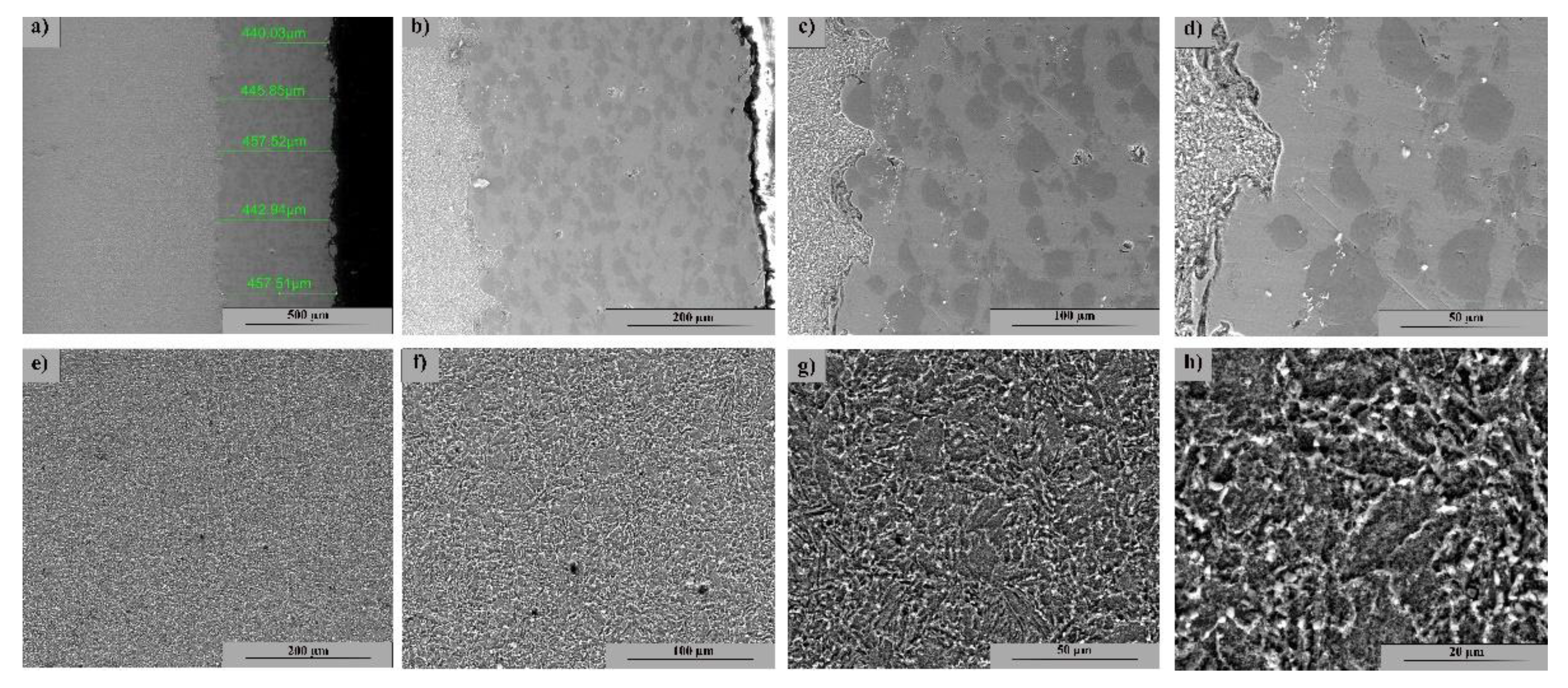
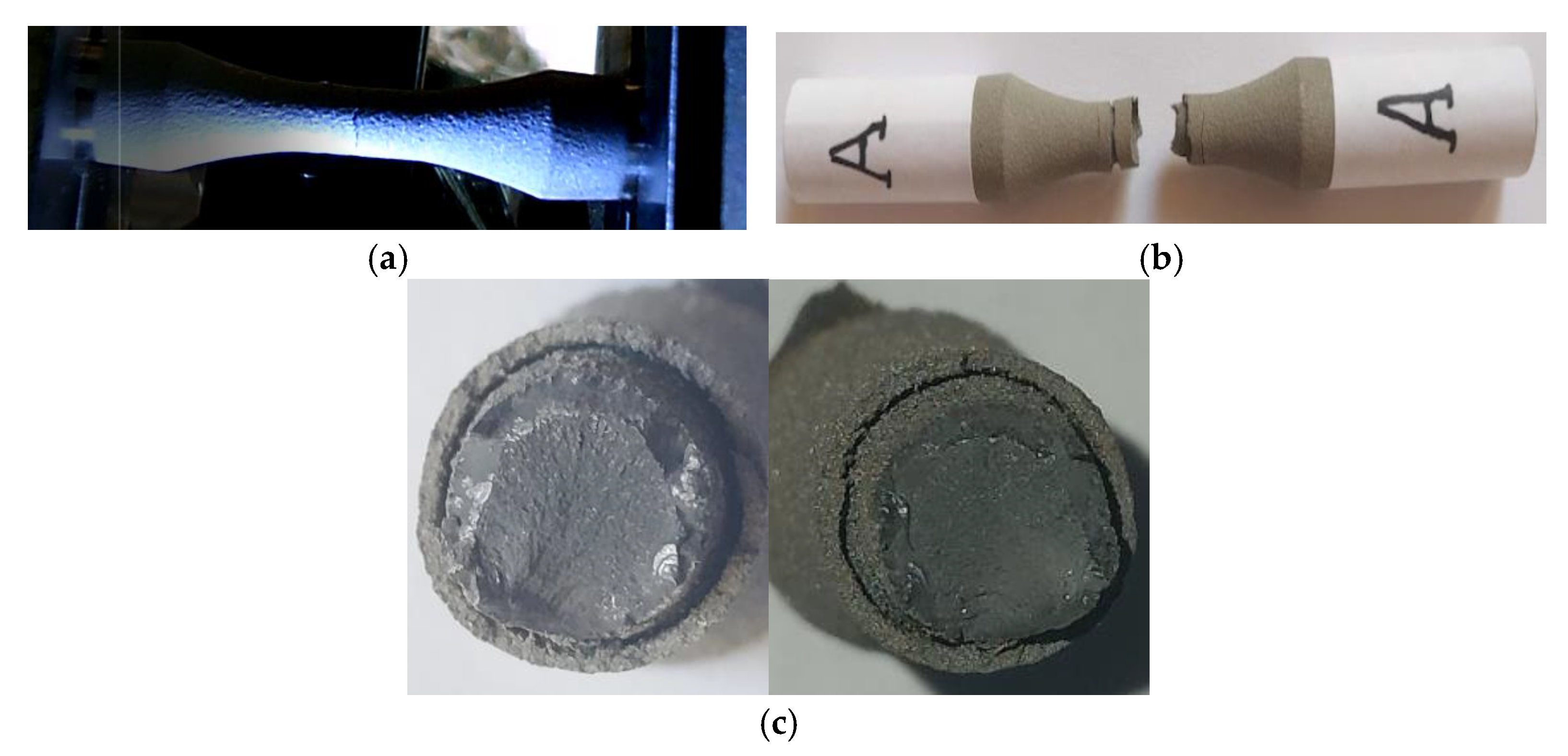
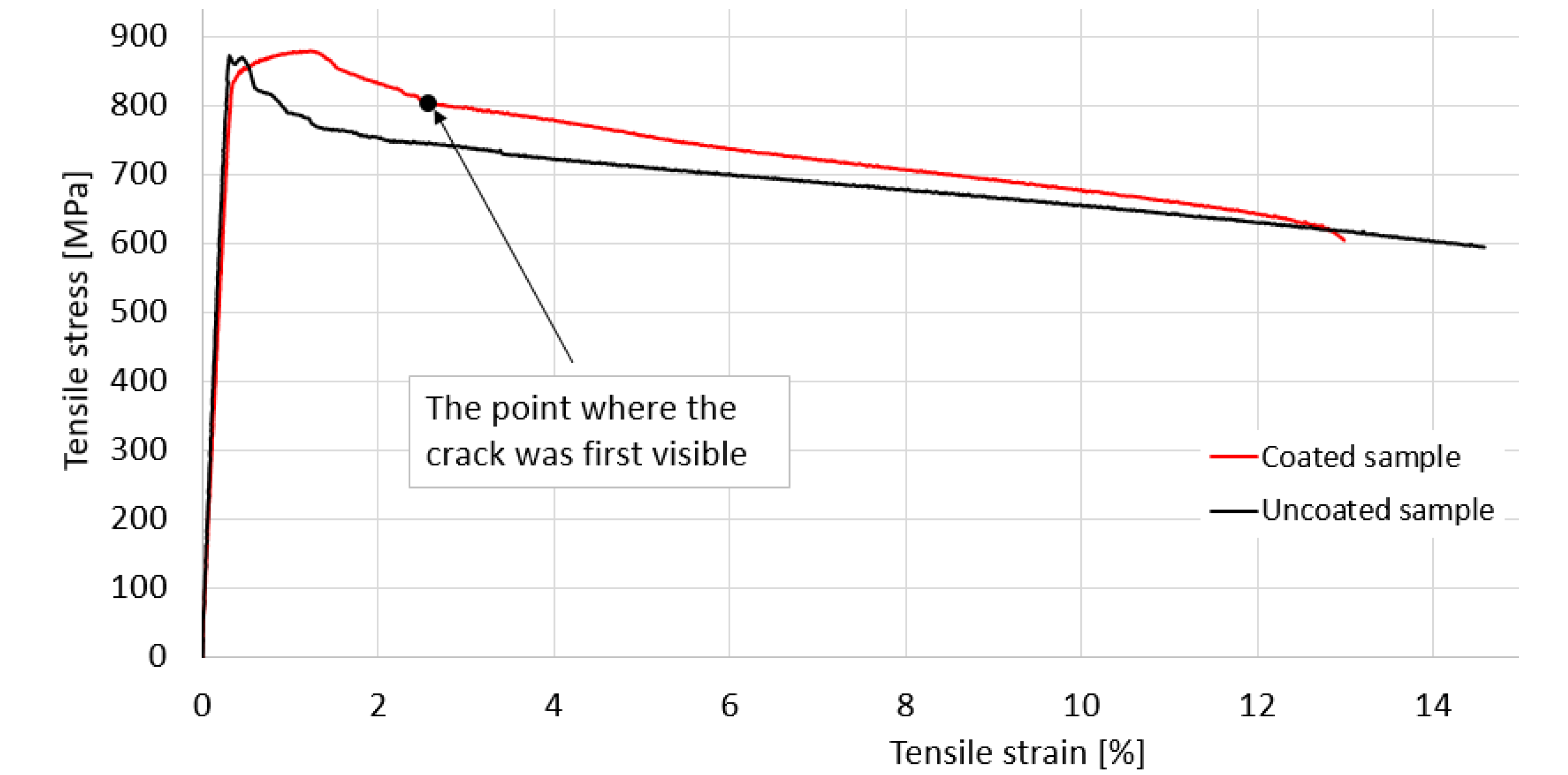
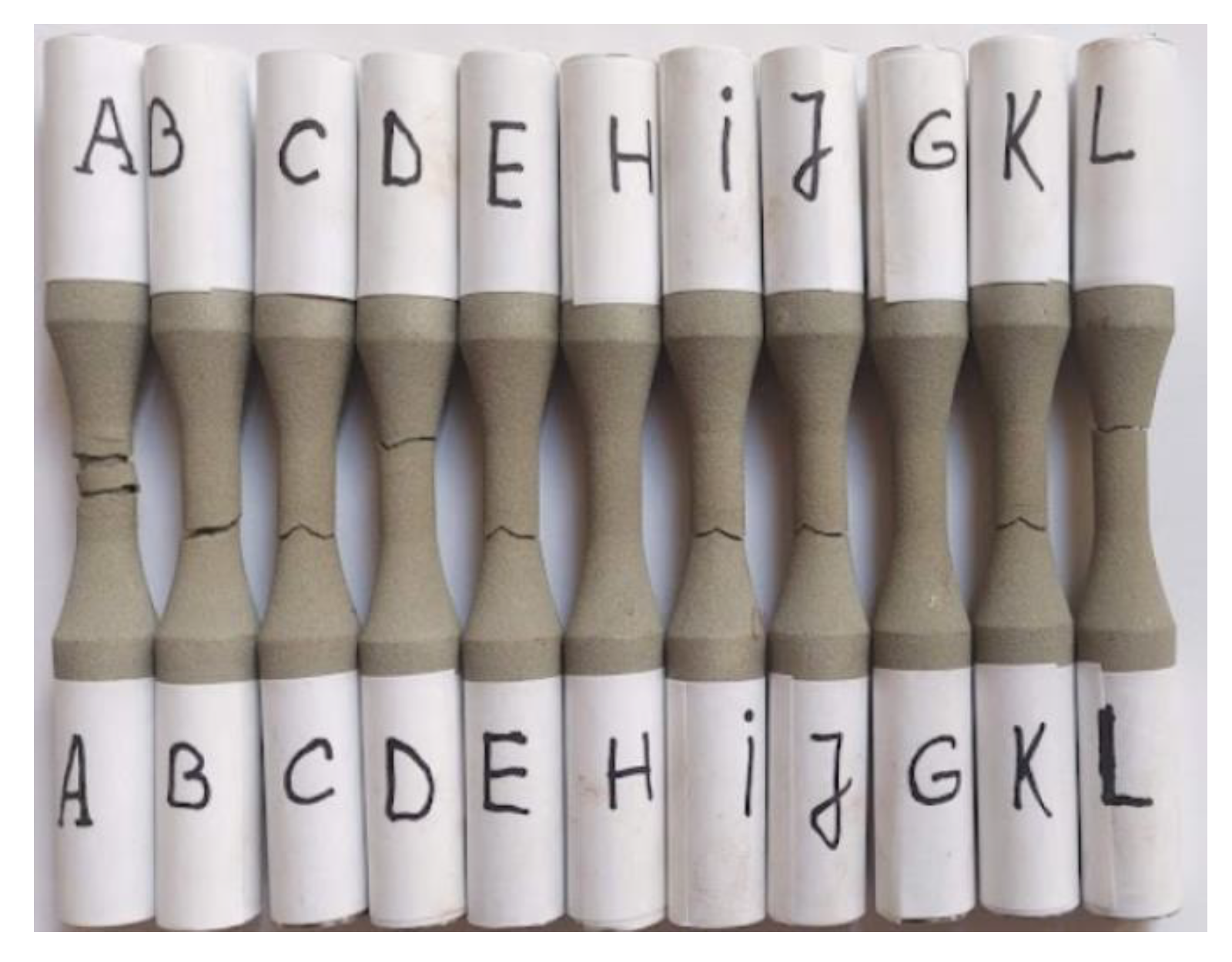
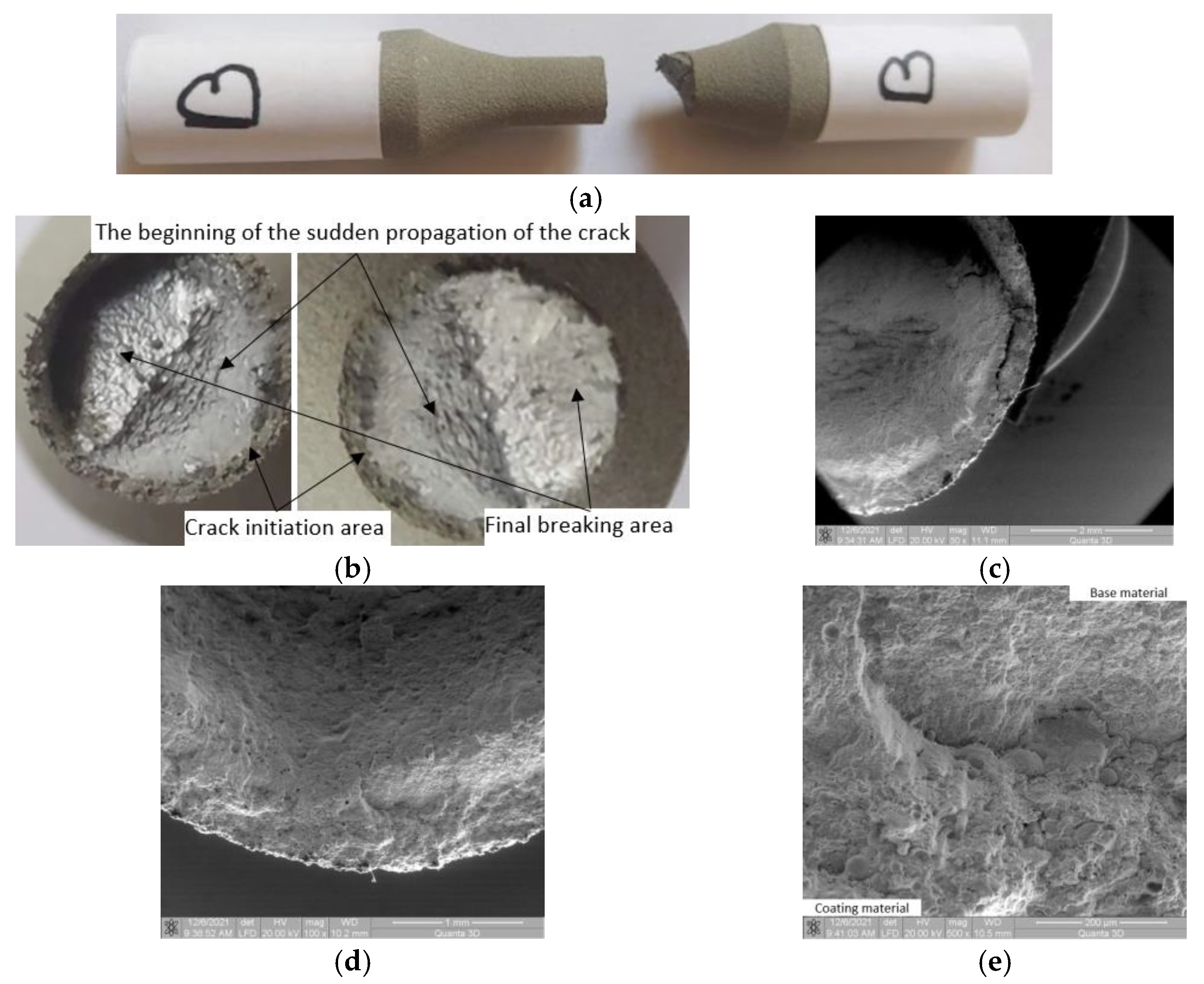
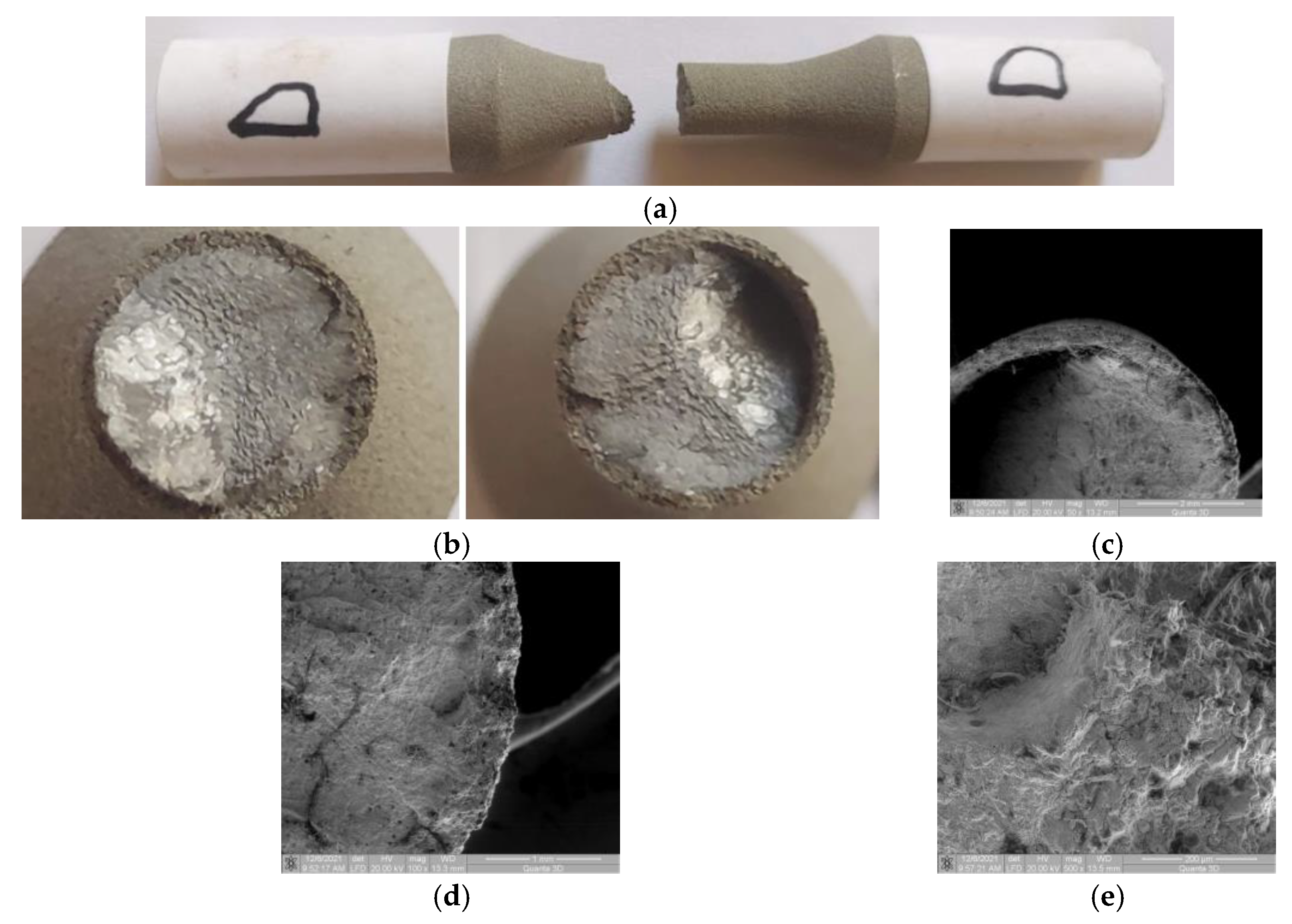
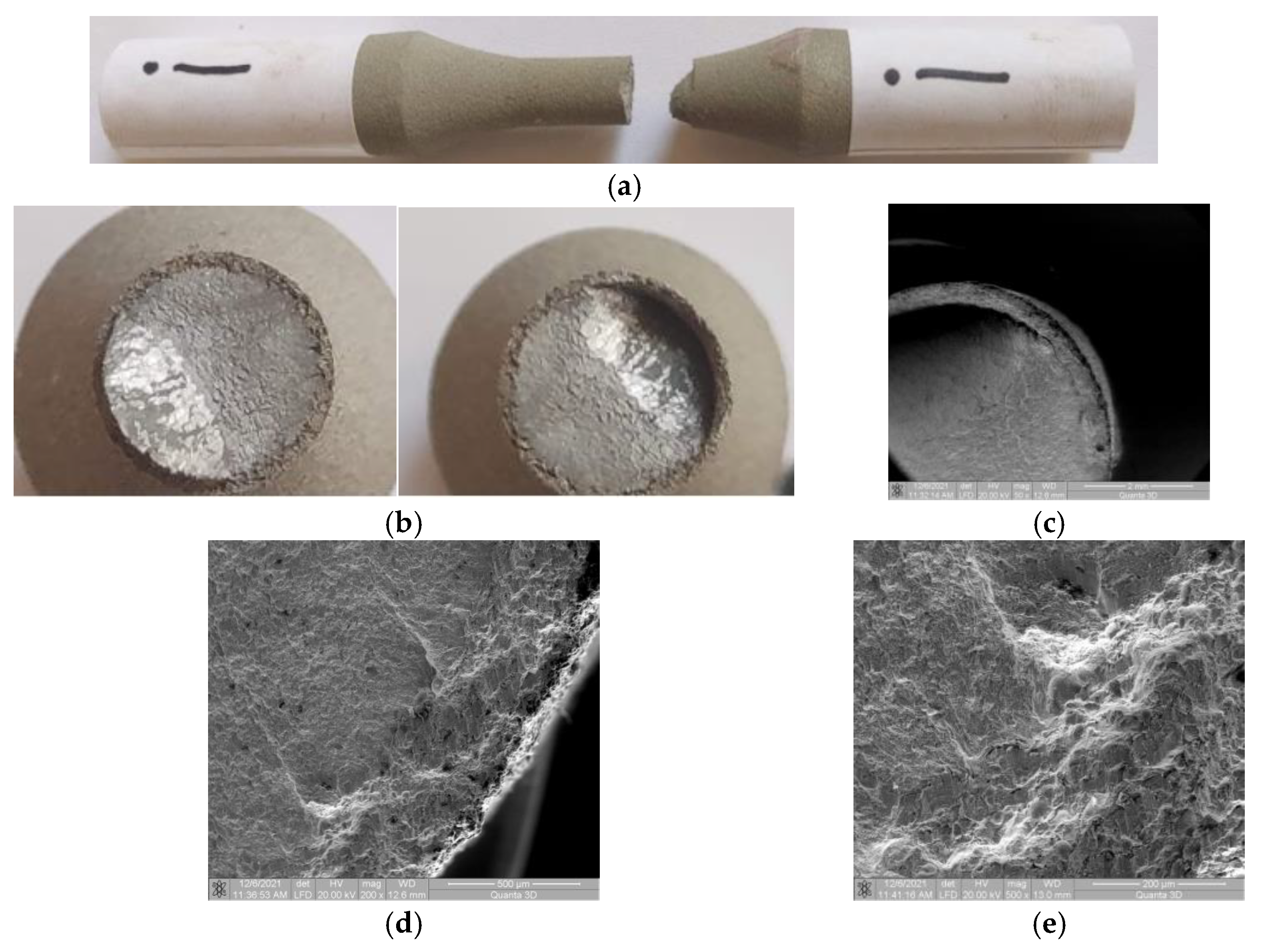
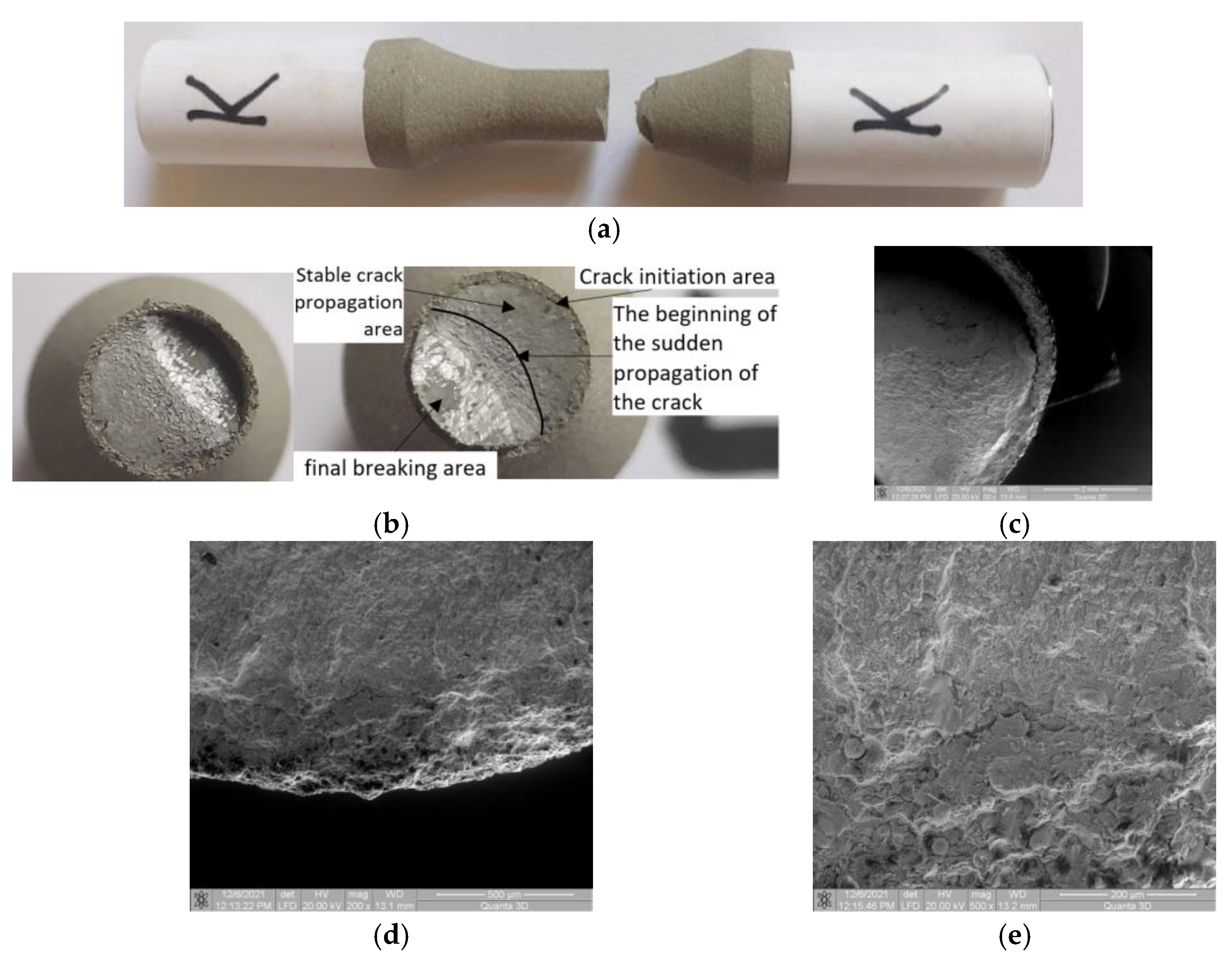

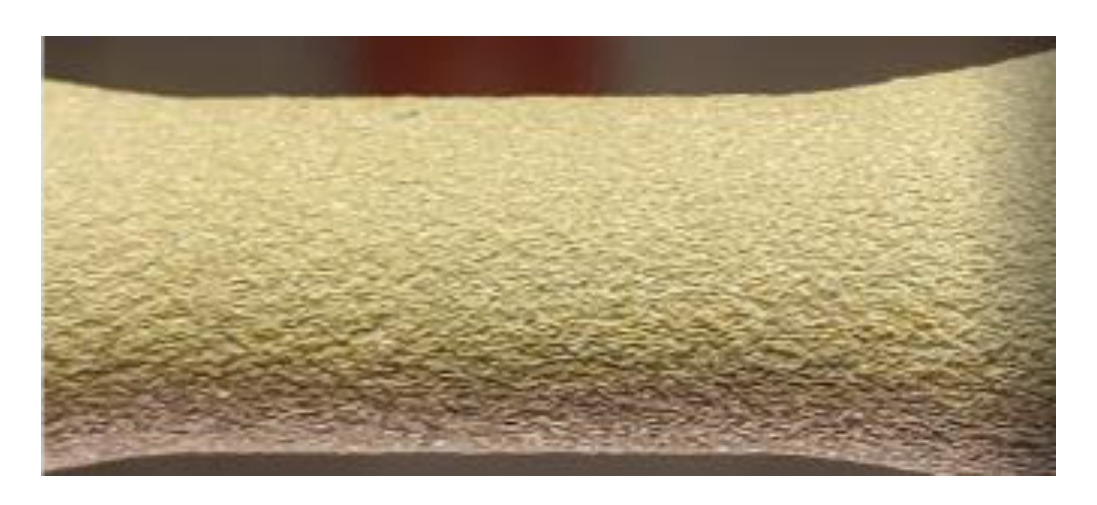

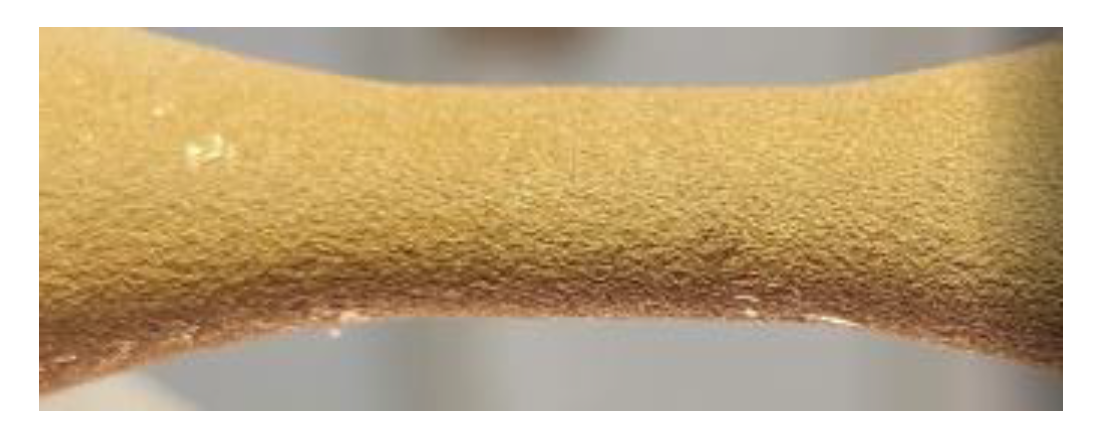


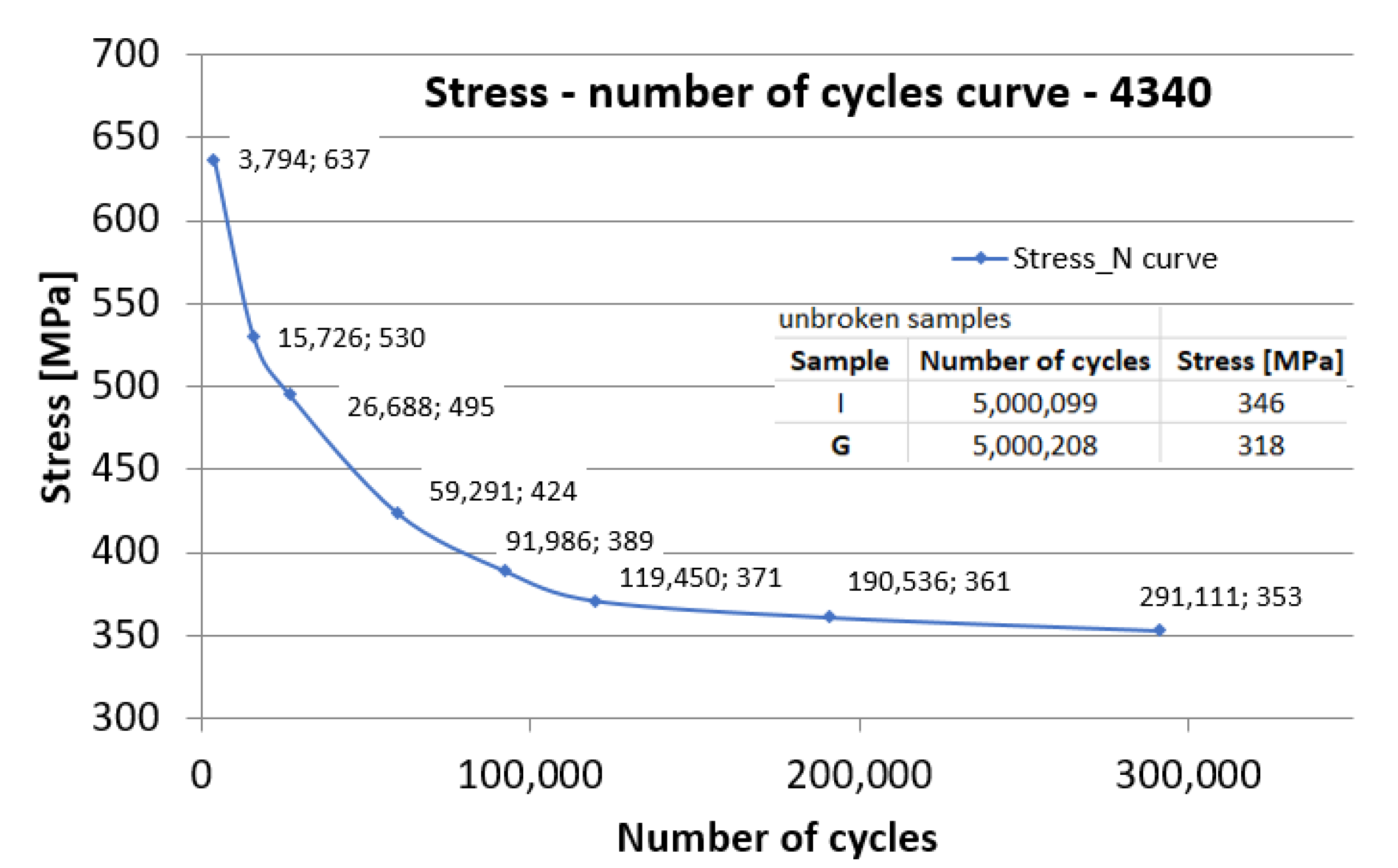
| Parameter | Value |
|---|---|
| Gas | Nitrogen |
| Pressure | 6.2 MPa (900 psi) |
| Temperature | 675 °C |
| Nozzle ID | WC NZL0060 |
| Nozzle throat size | 2 mm |
| Powder feeder speed | 10 rpm |
| Powder feeder gas flow | 105 slm |
| Standoff distance | 25 mm |
| Spray angle | 90 deg. |
| Nozzle traverse speed | 250 mm/s |
| Nozzle step distance | 0.25 mm |
| Layer thickness | 0.127 mm |
| Target coating thickness | 0.508 mm |
| Powder | WIP-C1 |
| Bond coat | WIP-BC1 and 60° |
| Sample No. | σmax (MPa) | N |
|---|---|---|
| B | 637 | 3794 |
| C | 530 | 15,726 |
| D | 495 | 26,688 |
| E | 424 | 59,291 |
| I | 389 | 91,986 |
| J | 371 | 119,450 |
| K | 361 | 190,536 |
| L | 352 | 291,111 |
Publisher’s Note: MDPI stays neutral with regard to jurisdictional claims in published maps and institutional affiliations. |
© 2022 by the authors. Licensee MDPI, Basel, Switzerland. This article is an open access article distributed under the terms and conditions of the Creative Commons Attribution (CC BY) license (https://creativecommons.org/licenses/by/4.0/).
Share and Cite
Goanță, V.; Munteanu, C.; Müftü, S.; Istrate, B.; Schwartz, P.; Boese, S.; Ferguson, G.; Morăraș, C.-I.; Stefan, A. Evaluation of the Fatigue Behavior and Failure Mechanisms of 4340 Steel Coated with WIP-C1 (Ni/CrC) by Cold Spray. Materials 2022, 15, 8116. https://doi.org/10.3390/ma15228116
Goanță V, Munteanu C, Müftü S, Istrate B, Schwartz P, Boese S, Ferguson G, Morăraș C-I, Stefan A. Evaluation of the Fatigue Behavior and Failure Mechanisms of 4340 Steel Coated with WIP-C1 (Ni/CrC) by Cold Spray. Materials. 2022; 15(22):8116. https://doi.org/10.3390/ma15228116
Chicago/Turabian StyleGoanță, Viorel, Corneliu Munteanu, Sinan Müftü, Bogdan Istrate, Patricia Schwartz, Samuel Boese, Gehn Ferguson, Ciprian-Ionuț Morăraș, and Adrian Stefan. 2022. "Evaluation of the Fatigue Behavior and Failure Mechanisms of 4340 Steel Coated with WIP-C1 (Ni/CrC) by Cold Spray" Materials 15, no. 22: 8116. https://doi.org/10.3390/ma15228116









